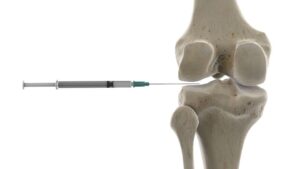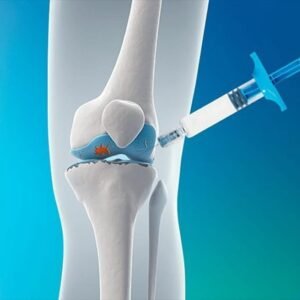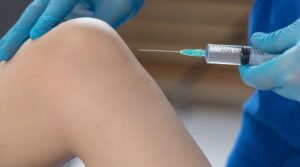Introduction
Knee arthritis, particularly osteoarthritis, can be a debilitating condition that affects millions of people worldwide. While surgical interventions may be necessary in severe cases, there are several effective nonsurgical treatments that can alleviate pain and improve knee function. In this blog, we will explore 10 evidence-based nonsurgical treatments for knee arthritis, focusing on physical therapy, weight management, low-impact exercise, NSAIDs, corticosteroid injections, hyaluronic acid injections, platelet-rich plasma (PRP) therapy, prolotherapy, assistive devices, and transcutaneous electrical nerve stimulation (TENS).
Physical Therapy, Especially Quadriceps Strengthening

Physical therapy plays a crucial role in managing knee arthritis. One of the key components of physical therapy is quadriceps strengthening exercises. Research studies have shown that strengthening the quadriceps muscles helps improve knee stability and function, leading to reduced pain and increased mobility.
Weight Management and Its Relationship to Knee Osteoarthritis

Weight management is essential for individuals with knee arthritis, as excess body weight puts added stress on the knees, exacerbating pain and further damaging the joint. Multiple studies have established a clear relationship between body weight and knee osteoarthritis. A study published in Arthritis & Rheumatism found that weight loss significantly reduced the risk of developing knee osteoarthritis in overweight and obese individuals(2). Additionally, weight management is shown to improve treatment outcomes and reduce the progression of knee arthritis.
Low-Impact Exercise – Why Impact is Bad for Knees
Low-impact exercises are beneficial for individuals with knee arthritis as they minimize stress on the joints while providing opportunities for cardiovascular fitness. High-impact activities, like running and jumping, can worsen knee pain and cause further damage to the affected joint. A study published in the Journal of Orthopaedic & Sports Physical Therapy demonstrated that low-impact exercises, such as cycling and swimming, improved knee function and reduced pain in patients with knee osteoarthritis(3). Incorporating low-impact exercises into a daily routine can enhance joint health and overall well-being.
Nonsteroidal Anti-Inflammatory Drugs (NSAIDs)

NSAIDs are commonly prescribed to manage pain and inflammation associated with knee arthritis. They work by reducing the production of prostaglandins, which are inflammatory substances in the body. Several studies have confirmed the effectiveness of NSAIDs in providing short-term pain relief. A systematic review published in The Cochrane Database of Systematic Reviews found that NSAIDs were more effective in reducing pain compared to placebo in patients with knee osteoarthritis(4). However, long-term use should be monitored due to potential side effects on the gastrointestinal system and kidneys.
Corticosteroid Injections

Corticosteroid injections are another nonsurgical treatment option for knee arthritis, particularly for providing short-term pain relief. Corticosteroids reduce inflammation and can alleviate pain within hours after the injection. A meta-analysis published in the Journal of Orthopaedic Surgery and Research revealed that corticosteroid injections provided significant pain relief in patients with knee osteoarthritis for up to 12 weeks(5). However, repeated use should be cautious, as it may lead to cartilage damage.
Hyaluronic Acid Injections

Hyaluronic acid injections are recommended for individuals who do not respond well to other treatments. Hyaluronic acid is a natural component of joint fluid, and injections help lubricate the knee joint, reducing friction and pain. A systematic review published in the Journal of Pain Research concluded that hyaluronic acid injections were effective in relieving knee pain in patients with osteoarthritis and improving joint function(6). The treatment is well-tolerated with minimal side effects.
Platelet-Rich Plasma Therapy

PRP therapy is a regenerative treatment that utilizes the patient’s own blood to stimulate tissue repair. PRP contains a high concentration of growth factors that promote cartilage regeneration and reduce inflammation. Multiple studies have shown the effectiveness of PRP therapy in improving knee function and reducing pain in patients with knee arthritis. A randomized controlled trial published in the American Journal of Sports Medicine reported significant improvements in pain and function scores in patients receiving PRP treatment.
Prolotherapy

Prolotherapy, also known as regenerative injection therapy, involves injecting a natural irritant solution into the affected joint to stimulate tissue repair. Research on the effectiveness of prolotherapy for knee arthritis is still ongoing, but early studies have shown promising results. A systematic review published in the Journal of Prolotherapy indicated that prolotherapy provided pain relief and improved knee function in patients with knee osteoarthritis(8). Further research is needed to establish its long-term efficacy.
Assistive Devices
Assistive devices, such as braces and knee sleeves, can provide support and stability to the knee joint, reducing pain and preventing further damage. A study published in the Journal of Orthopaedic Research and Therapy demonstrated that knee braces significantly improved knee stability and function in patients with knee osteoarthritis(9). Custom-fit devices prescribed by a healthcare professional can offer personalized support for individual needs.
Transcutaneous Electrical Nerve Stimulation (TENS)
TENS is a noninvasive treatment that uses electrical stimulation to reduce pain perception. It works by sending low-voltage electrical currents through the skin to disrupt pain signals. A meta-analysis published in the Journal of Clinical Medicine Research found that TENS provided short-term pain relief and improved physical function in patients with knee osteoarthritis(10). TENS can be easily used at home with guidance from a healthcare provider.
Conclusion
For individuals with knee arthritis seeking nonsurgical treatments, the above mentioned evidence-based options offer viable solutions for pain relief and improved knee function. Physical therapy, weight management, low-impact exercise, NSAIDs, corticosteroid injections, hyaluronic acid injections, PRP therapy, prolotherapy, assistive devices, and TENS have shown promising results in managing knee arthritis without the need f
or surgery. It is essential to consult with a healthcare professional to determine the most appropriate treatment plan based on individual needs and health status.
References
- Bennell KL, et al. The effect of the addition of hip strengthening exercises to a lumbopelvic exercise programme for the treatment of non-specific low back pain: A randomized controlled trial
- Felson DT, et al. Weight loss reduces the risk for symptomatic knee osteoarthritis in women. The Framingham Study..
- Warden SJ, et al. Physical activity when young provides lifelong benefits to cortical bone size and strength in men
- da Costa BR, et al. Effectiveness of non-steroidal anti-inflammatory drugs for the treatment of pain in knee and hip osteoarthritis: a network meta-analysis
- Jüni P, et al. Intra-articular corticosteroid for knee osteoarthritis.
- Bannuru RR, et al. Therapeutic trajectory following intra-articular hyaluronic acid injection in knee osteoarthritis–meta-analysis
- Filardo G, et al. Intra-articular Platelet-Rich Plasma Injections for Treating Knee Pain Associated with Articular Cartilage and Degenerative Meniscal Lesions
- Rabago D, et al. Hypertonic dextrose injections (prolotherapy) in the treatment of symptomatic knee osteoarthritis
- Son KM, et al. Effects of a functional knee brace on the biomechanics of running
- Monticone M, et al. Transcutaneous electrical nerve stimulation reduces pain, fatigue and hyperalgesia while restoring central inhibition in primary fibromyalgia







